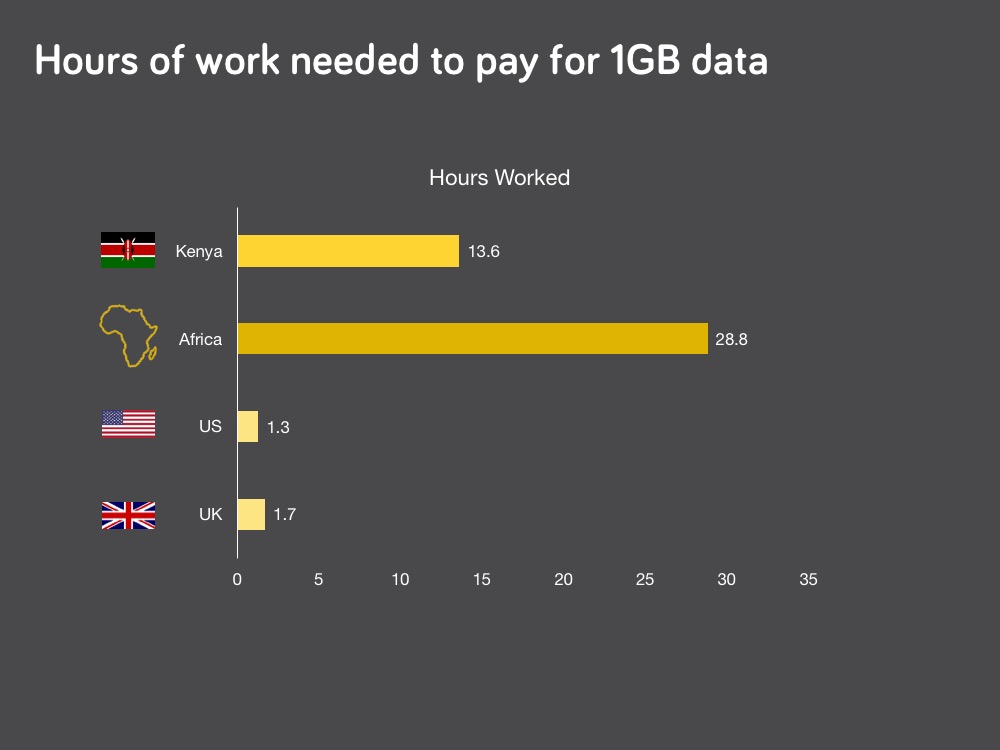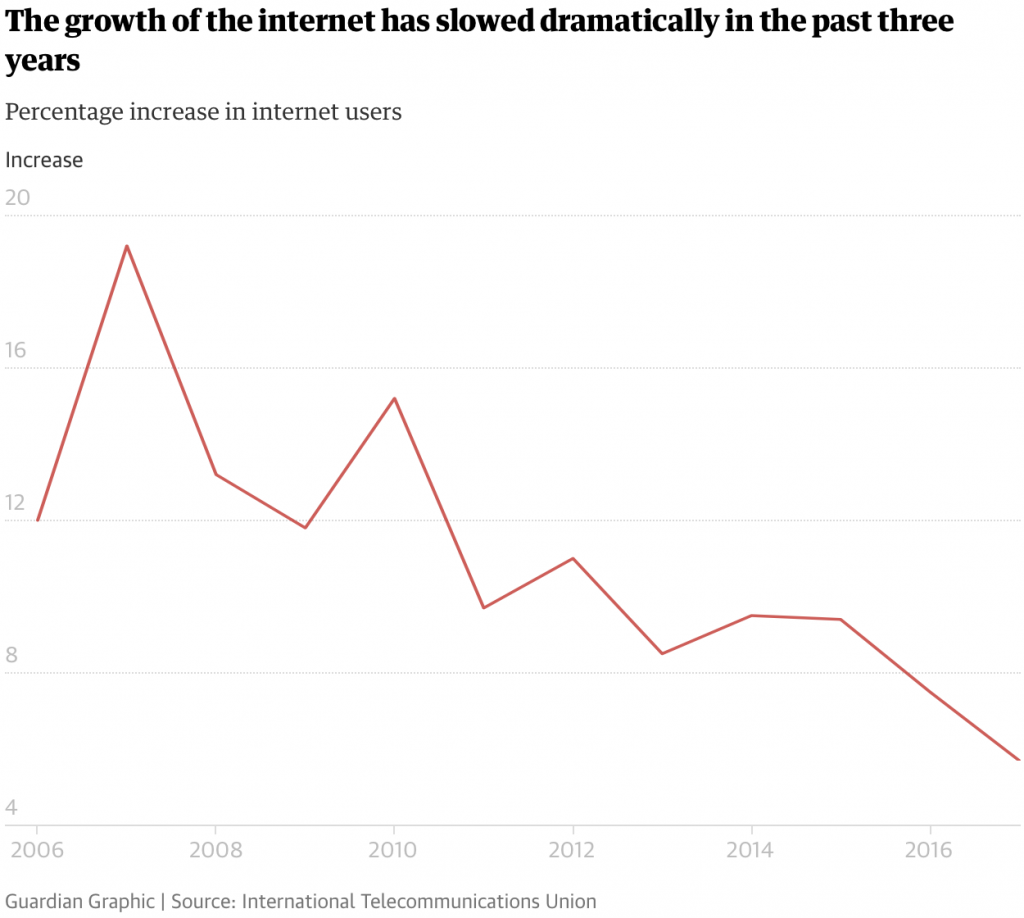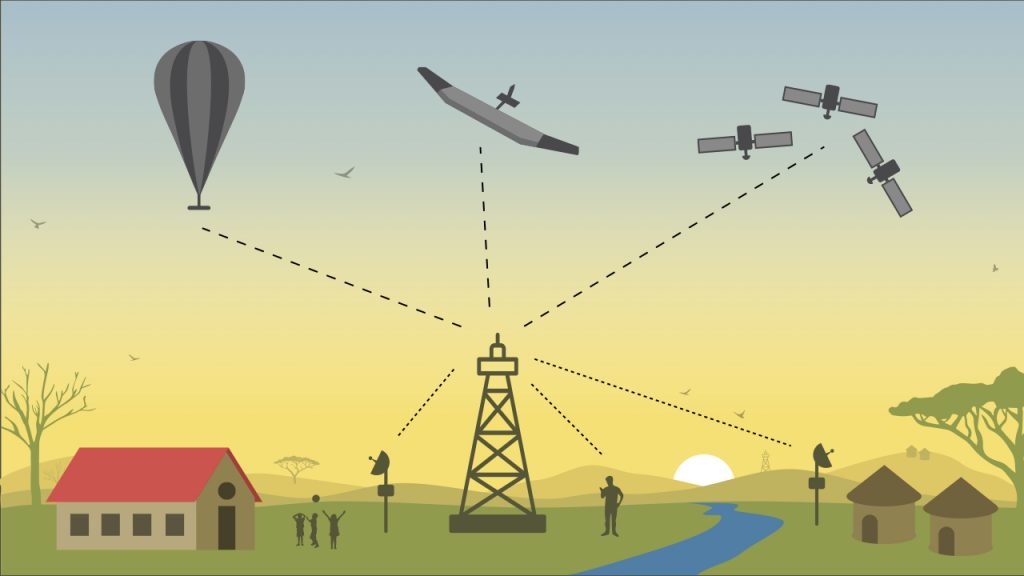The first few decades of the internet has been about getting the signal everywhere. The current decade is about making the internet affordable to everyone. The internet will be free, and the future belongs to those with the courage to create and fund the business models that support creating an onramp for that last blue ocean of internet users.
It takes someone in Africa four days of work to earn 1Gb of internet. In the US and Europe, it takes just two hours to do the same. (note: see bottom for the math on this)
Connectivity can be generally broken down into two buckets:
- Accessibility – which is generally about having the signal for the internet and the devices to connect to it.
- Affordability – the ability to pay for the internet.
There’s a good piece in Wired about the slow down in connectivity around the world. We’ve made great progress in the initial half of the world connecting to the internet, but the remaining half is coming along a lot slower, and at a decreasing speed each year.
“The data shows that growth in global internet access dropped from 19% in 2007 to less than 6% last year” The Guardian
Why?
For the last two decades we’ve been focused on some pretty big population numbers as well as more wealthy demographics; connecting cities (in both first-world and frontier markets) and the relatively prosperous populations of the world wherever they may be. Currently, on the accessibility front we’ve been forced to work in harder areas with less population density, where the numbers for a cell phone tower are slower to show their ROI, and where frankly it’s not worth using our older technology and our older business models to unlock the internet to that population.
So we come to an interesting time in history, where there is a lot of discussion about, “connecting the last 3 billion”, but not a great deal of courage in doing so.
Sidebar: since I’ve been sitting on an airplane for many hours, I watched the movie 1970 movie Patton, which is likely why I’m thinking so much of courage. In it he quotes Frederick the Great (possibly wrongly attributed) as saying:
“L’audace, l’audace. Toujours l’audace.”
“Audacity, audacity. Always audacity.”
And it is about courage. Most people look at the problem of the internet and think about current tech, or even future tech. They try to do something a little bit cheaper, maybe the go all out and and try something truly mind-blowing, such as balloons, satellites or drones. And, they each do play a small part. But, that’s it, small. We’re at a point where even these seemingly world-changing technologies are relatively small since there is a bigger picture that eclipses tech accessibility.
The big picture is that the internet will be free. Everywhere. Eventually.
Which means connecting the next 3 billion is a business model problem, not a technology problem.
If the is true, then let’s keep investing in these marginal accessibility changes. We need them, we truly do. Every time we get a new Viacom satellite, a Safaricom cell tower, a Google Loon balloon, or a new terrestrial cable dug across Africa or Asia, we get a needed marginal improvement. We push the costs down and the accessibility equation goes a tiny bit higher.
But back to courage. In our plans to connect the world to the internet, it doesn’t take a great deal of bravery to invest in a little bit more infrastructure. For these types of initiatives we’ve had our formulas for a decade or more, and we know they work. A few accountants and legal to check the boxes and a couple million more USD gets spent. We know how to charge for it, and that business model has seen but iterative change in two decades. We’ll always need cables and satellites, but in the world where the internet is free for everyone, it’s the business model that needs the most work.
So, how do we solve this business model for free internet? After all, the internet isn’t free, someone always pays.
It doesn’t come from charging a consumer who has limited disposable income. Just like the internet is moving to free in most public spaces in the US and Europe, I believe it will be the same in most of the rest of the world. The answer comes in looking for indirect revenue streams, and there are multiple paths to this.
This is where the big companies have let us down. Not due to their lack of investment, but to their lack of creativity. Whether it’s with satellite companies who provide low cost subscriber models, helping a moderate percentage more of the population get online regularly, or the Google Loons that side with telecom oligopolies, or the ISPs and mobile phone companies that are too deeply entrenched in their legacy business models to make any meaningful change.
Large organizations have a lot of resources. But… these same large organizations don’t think creatively enough about the solution.
Too many resources tends towards lazy problem solving. After all, if you’re a heavyweight going up against a featherweight, your only strategy need be bludgeon your competitor to defeat. In our world, a lot of money starts feeling like a hammer that you can start bludgeoning with – which tends towards solutions like the original “Free Basics” from Facebook, which looked a lot like an organization trying to do the right thing and then realizing that they couldn’t afford to give everyone the whole internet for free, so instead tried to make a good bit of it free – and ended up with a useful walled garden that set a lot of people on edge.
Compounding this is that the people making decisions around the initiatives at these larger organizations are not the entrepreneurs who built the company, they’re middle managers who like to reduce their risk profile inside the organization so that they can maintain their nice salaries and perks.
But, we can make the whole internet free, and we don’t have to buy it. What we need is a bit more creativity in coming up with new business models that represent the future of connectivity, not the past.
So, if big organizations aren’t the answer, and old infrastructure models are just iterative change, then what is the answer?
It’s a combination. Matching up the resources (and capitalist business models) of these large organizations to get these new users onto their platforms, and the creative solutions that come from smaller, hungrier companies give us a wonderful blend. When these two come together, interesting and explosive change can happen.
I’ve seen all of this first hand. Both the marginal change of the aforementioned global organization efforts alone (or worse, paired with some other large organization), as well as the magic of what happens when one of them works with a smaller company that has a real ground game and understands the problem from a different level.
I’m convinced that we’re solving this right now at BRCK, and that’s due in no small part to the infrastructure team we’ve had the chance to work with at Facebook. We’re not the only ones either, I’m seeing some other companies working on some pretty neat solutions too that gives me optimism for actually solving this problem. The only thing we need is more of the large companies to embrace some of these changes and work together with the companies on the ground in Africa, Asia and Latin America.


